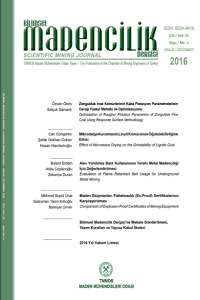THE SIZE CORRECTION AND CORRELATION OF POINT LOAD INDEX WITH COMPRESSIVE STRENGTH OF SOME DIMENSION STONES OF TECTONIC ZONES, NORTH PAKISTAN
The Uniaxial compressive strength (UCS) is an important geotechnical property of rock used in tunnel design, rock mass classification and other surface and underground mining projects. It is the Key parameter of rock mass rating (RMR) and the RMR is the basic of all the slope stability analyses methods. This key parameter of slope stability analyses and tunneling can be determine easily by axial and diametral point load test (PLI/Is50). In the past irregular lumps PLI is also correlated with UCS but the data is limited particularly the rocks along Karakoram High Way (KKH), North Pakistan. In this study the diametral, axial and the irregular lumps PLI is correlated with UCS using dimension stones of tectonic regions along KKH. A methodology of size correction of irregular lumps have been set. Using regression analyses the PLI of cores and lumps have been correlated with UCS. The significance of the correlation were developed by correlations coefficients. It is found that the Is(50) of irregular lump of white marble is 1.8MPa. For pink and white granite the Is(50) value is recorded as 3.2MPa and 2.4MPa respectively. In the size correction factor (F) the power n for irregular lump is corrected as 0.8 for marble lumps and the n value for pink and white granite is 0.9 and 1.4 respectively. For diametral and axial PLI the power n is used as 0.45. The correction factor F=(De/50)0.8 is suggested for marble irregular lumps while for axial and diametral specimens of marble the correction factor is F=(De/50)0.45 is recommended. In the case of pink and white granite the correction factors are F=(De/50)0.9 and F=(De/50)1.4 respectively.
Anahtar Kelimeler:
Uniaxial compressive strength, Point load index, correlation, irregular lumps, size correction
THE SIZE CORRECTION AND CORRELATION OF POINT LOAD INDEX WITH COMPRESSIVE STRENGTH OF SOME DIMENSION STONES OF TECTONIC ZONES, NORTH PAKISTAN
The Uniaxial compressive strength (UCS) is an important geotechnical property of rock used in tunnel design, rock mass classification and other surface and underground mining projects. It is the Key parameter of rock mass rating (RMR) and the RMR is the basic of all the slope stability analyses methods. This key parameter of slope stability analyses and tunneling can be determine easily by axial and diametral point load test (PLI/Is50). In the past irregular lumps PLI is also correlated with UCS but the data is limited particularly the rocks along Karakoram High Way (KKH), North Pakistan. In this study the diametral, axial and the irregular lumps PLI is correlated with UCS using dimension stones of tectonic regions along KKH. A methodology of size correction of irregular lumps have been set. Using regression analyses the PLI of cores and lumps have been correlated with UCS. The significance of the correlation were developed by correlations coefficients. It is found that the Is(50) of irregular lump of white marble is 1.8MPa. For pink and white granite the Is(50) value is recorded as 3.2MPa and 2.4MPa respectively. In the size correction factor (F) the power n for irregular lump is corrected as 0.8 for marble lumps and the n value for pink and white granite is 0.9 and 1.4 respectively. For diametral and axial PLI the power n is used as 0.45. The correction factor F=(De/50)0.8 is suggested for marble irregular lumps while for axial and diametral specimens of marble the correction factor is F=(De/50)0.45 is recommended. In the case of pink and white granite the correction factors are F=(De/50)0.9 and F=(De/50)1.4 respectively.
Keywords:
: Uniaxial compressive strength, Point load index, correlation, irregular lumps, size correction.,
___
- Akram, M., & Bakar, M. A. (2016). Correlation between uniaxial compressive strength and point load index for salt-range rocks. Pakistan Journal of Engineering and Applied Sciences.
- ASTM, D. (2006). Standard test method for unconfined compressive strength of cohesive soil. ASTM standard D, 2166.
- Bieniawski, Z. (1975). The point-load test in geotechnical practice. Engineering Geology, 9(1), 1-11.
- D'Andrea, D. V., Fischer, R., & Fogelson, D. (1965). Prediction of compressive strength from other rock properties (Vol. 6702): US Department of the Interior, Bureau of Mines.
- Fener, M., Kahraman, S., Bilgil, A., & Gunaydin, O. (2005). A comparative evaluation of indirect methods to estimate the compressive strength of rocks. Rock Mechanics and Rock Engineering, 38(4), 329-343.
- Franklin, J. (1985). Suggested method for determining point load strength. Paper presented at the International Journal of Rock Mechanics and Mining Sciences & Geomechanics Abstracts.
- Kahraman, S., & Gunaydin, O. (2009). The effect of rock classes on the relation between uniaxial compressive strength and point load index. Bulletin of Engineering Geology and the Environment, 68(3), 345-353.
- Panek, L., & Fannon, T. (1992). Size and shape effects in point load tests of irregular rock fragments. Rock Mechanics and Rock Engineering, 25(2), 109-140.
- Protodyakonov, M. (1960). New methods of determining mechanical properties of rocks. Paper presented at the Proceedings of the International Conference on Strata Control.
- Raza, S., Hussain, S., Jadoon, K., Rehman, Z., Sherin, S., & Muhammad, N. (2020). Mitigation plan for identified problems faced by the marble industry in Khyber Pakhtunkhwa. Journal of Engineering and Applied Sciences, 39(1), 77-86.
- Rusnak, J., & Mark, C. (2000). Using the point load test to determine the uniaxial compressive strength of coal measure rock.
- Sabatakakis, N., Koukis, G., Tsiambaos, G., & Papanakli, S. (2008). Index properties and strength variation controlled by microstructure for sedimentary rocks. Engineering Geology, 97(1-2), 80-90.
- Yin, J.-H., Wong, R. H., Chau, K. T., Lai, D. T., & Zhao, G.-S. (2017). Point load strength index of granitic irregular lumps: Size correction and correlation with uniaxial compressive strength. Tunnelling and Underground Space Technology, 70, 388-399.
- ISSN: 2564-7024
- Başlangıç: 1960
- Yayıncı: TMMOB Maden Mühendisleri Odası
